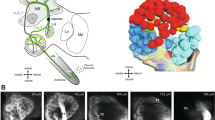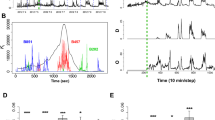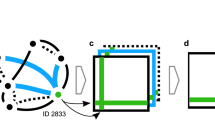Abstract
Although bumble-bees are highly social insects, their foraging has been considered to be managed as an individual initiative1,2,3,4, in which each bumble-bee visits flowers not only to collect food, but also to gather information about other potential food sources5. Here we show that bumble-bees instead use a primitive, but surprisingly efficient, recruitment system: by performing extended excitatory runs in the nest, a single successful forager can alert the entire foraging force of a bumble-bee colony. But in contrast to what happens in other social bees, such as honeybees, the recruits are not informed about the location of the food. Instead, the successful forager brings home the odour of the newly discovered food source, conveying to the recruits information about the species of flower. These findings about bumble-bee communication shed new light on the early evolutionary origins of the elaborate dance language of the honeybee.
Similar content being viewed by others
Main
To investigate whether bumble-bees (Bombus terrestris) can communicate information about the discovery of a food source, we connected a nest box with a bipartite flight arena. A single forager was allowed to collect sucrose solution from an artificial flower in one half of the arena, whereas all other bees had access only to the other half of the arena, which did not contain food. This procedure ensured that interactions between bees could take place only in the nest, not at the food source. The number of bees entering the empty flight arena to search for food was counted during 12 periods of 1 hour each, when foragers were rewarded.
When compared with unrewarded control periods, the searching activity strongly increased when a single bee foraged (P<0.01, Wilcoxon test; Fig. 1a). Successful foragers in the nest, instead of just emptying their crop load and continuing to forage, would typically spend several minutes running across the nest, frequently bumping into nestmates and occasionally buzzing their wings.
Odour-preference tests indicated that bees leaving the hive strongly preferred the odour that was brought home by the forager (n=90, P<0.001, χ2 test; Fig. 1b). Because floral scents are species specific, the odour helps recruits to find the food source used by the successful forager. To test whether positional information is also conveyed, we trained three foragers to collect sucrose from a feeder positioned 100 m west of the hive in an open field. Recruits had the choice between that feeder and two additional feeders placed 100 m north and south of the nest. New recruits distributed themselves randomly at these three feeders (P=0.21; χ2 test). This failure of bumble-bees to recruit to specific points in space may explain why their communication has previously been overlooked. Bumble-bees therefore have a recruitment system that is specific for a flower species but independent of its location. This system for transmitting information resembles the round dance used by honeybees when food is found in the immediate vicinity of the hive1,6.
But why have bumble-bees not evolved a communication system that includes information about where to forage? Such a system can be very costly. Honeybee recruits may take more than an hour to decide where to go, even if only two different locations are advertised7. They also take a long time to find a food source after receiving information about its location8.
Bumble-bees live in small colonies, mainly in temperate habitats where floral food is less clumped than in the tropical habitats where the communication of honeybees and stingless bees evolved1,5,6. The advantage of communicating location might therefore not offset the cost. It may be sufficient to specify flower species to recruits, who can then rely on their own memory or searching ability to find flowers but still know when and for what to forage.
Understanding the communication of bumble-bees is central to reconstructing the evolutionary origins of the honeybees' waggle dance, which is one of the most complex systems in animal communication. Such a reconstruction requires us to compare the honeybees' behaviour with that of their extant relatives, the bumblebees and stingless bees, which have excitatory motor patterns that serve to recruit nestmates to food sources9. This behaviour may be derived from a social facilitation of activity at the nest entrance, which is widespread among social insects10. Bumble-bees also share with stingless bees9 and honeybees1,6 the ability to learn the floral odours brought back by returning foragers. The bumble-bee recruitment system might therefore resemble that of the last common ancestor of the eusocial bees.
References
Frisch, K. v. Tanzsprache und Orientierung der Bienen (Springer, Heidelberg, 1965).
Esch, H. Sci. Am. 217, 97–104 (1977).
Dukas, R. & Real, L. A. Oecologia 94, 244–246 (1993).
Kirchner, W. H. & Towne, W. F. Sci. Am. 270, 74–81 (1994).
Heinrich, B. Bumblebee Economics (Harvard Univ. Press, Cambridge, Massachusetts, 1979).
Seeley, T. The Wisdom of the Hive: The Social Physiology of Honey Bee Colonies (Harvard Univ. Press, Cambridge, Massachusetts, 1995).
Michelsen, A., Lindauer, M. & Rohrseitz, K. in 27th Göttingen Neurobiology Conference (eds Elsner, N. & Eysel, U.) 258 (Thieme, Göttingen, 1999).
Wenner, A. M. & Wells, P. H. Anatomy of a Controversy (Columbia Univ. Press, New York, 1990).
Lindauer, M. & Kerr, W. E. Bee World 41, 29–71 (1960).
Blackith, R. E. Physiol. Comp. Oecol. 4, 388–402 (1957).
Author information
Authors and Affiliations
Corresponding author
Rights and permissions
About this article
Cite this article
Dornhaus, A., Chittka, L. Evolutionary origins of bee dances. Nature 401, 38 (1999). https://doi.org/10.1038/43372
Issue Date:
DOI: https://doi.org/10.1038/43372
This article is cited by
-
A comparative analysis of foraging route development by bumblebees and honey bees
Behavioral Ecology and Sociobiology (2024)
-
Temporal effects of sugar intake on fly local search and honey bee dance behaviour
Journal of Comparative Physiology A (2023)
-
Comparative psychophysics of Western honey bee (Apis mellifera) and stingless bee (Tetragonula carbonaria) colour purity and intensity perception
Journal of Comparative Physiology A (2022)
-
In-nest behavior by tandem recruiters of the ant Temnothorax rugatulus: effects of context and quality
Insectes Sociaux (2022)
-
Responses of butterflies to visual and olfactory signals of flowers of the bush lily Clivia miniata
Arthropod-Plant Interactions (2021)
Comments
By submitting a comment you agree to abide by our Terms and Community Guidelines. If you find something abusive or that does not comply with our terms or guidelines please flag it as inappropriate.




